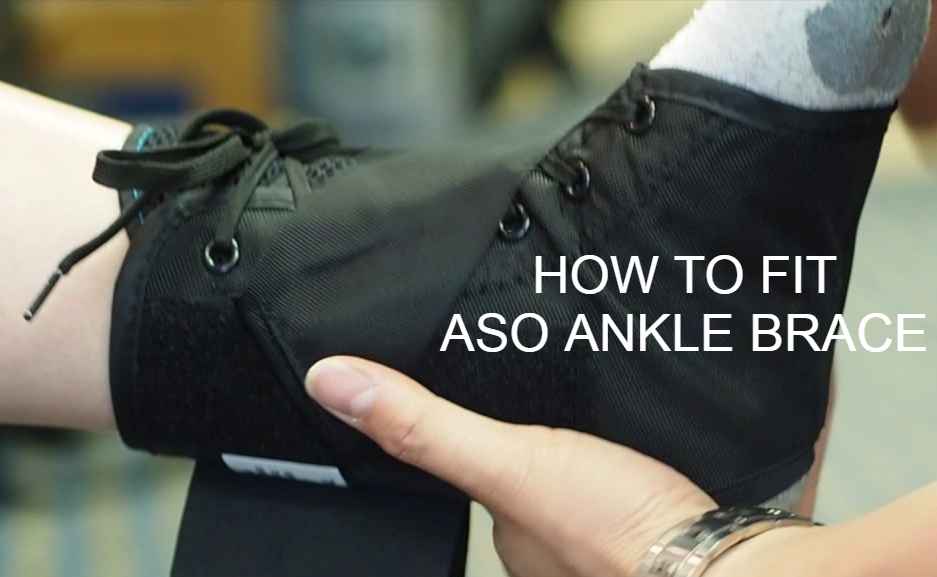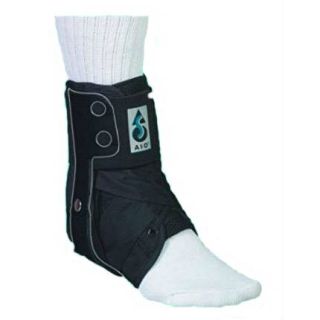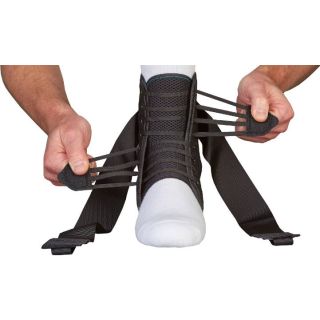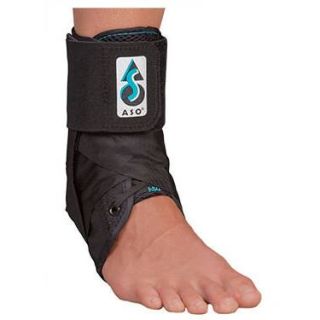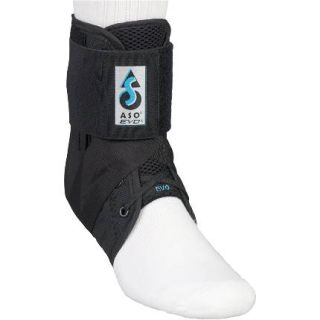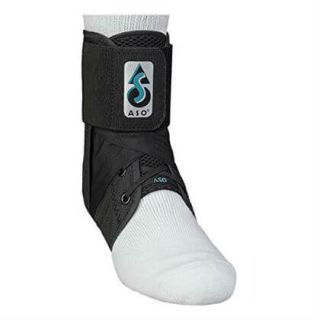How To Put On ASO Ankle Brace
June 9, 2023HOW TO PUT ON AN ASO ANKLE BRACE: MASTERING THE APPLICATION STEP-BY-STEP
Ankle braces play a crucial role in both injury recovery and prevention. The ASO ankle brace, also known as the Ankle Stabilizing Orthosis, is a popular and highly regarded ankle brace that provides exceptional support and stability for individuals recovering from ankle injuries or looking to prevent them. Here, we will introduce the ASO ankle brace and highlight its benefits:
- Design and Construction: The ASO ankle brace is constructed with high-quality materials, including durable nylon fabric and breathable CoolFlex material. It features figure-eight stabilizing straps that provide the same support as athletic taping. The brace is designed to fit snugly around the ankle, providing optimal stability and preventing excessive movement.
- Anatomical Support: The ASO ankle brace is anatomically contoured, conforming to the shape of the foot and ankle. This ensures a comfortable and secure fit, minimizing slippage or discomfort during wear. The brace offers support to the ligaments, tendons, and muscles surrounding the ankle, promoting proper alignment and reducing the risk of injuries.
- Adjustable Compression: The ASO ankle brace incorporates a lacing system that allows for customizable compression. By tightening or loosening the laces, users can achieve the desired level of support and compression, adapting to their specific needs and comfort preferences. The adjustable compression helps reduce swelling, inflammation, and discomfort in the ankle area.
- Flexibility and Range of Motion: While providing excellent support, the ASO ankle brace also allows for a certain degree of flexibility and range of motion. It permits natural movement of the foot and ankle, ensuring that essential mobility is not compromised. This feature is particularly beneficial during the rehabilitation phase, enabling gradual strengthening of the ankle joint.
- Versatility and Performance: The ASO ankle brace is suitable for a wide range of activities and sports, making it a versatile choice for individuals with varying needs. Whether you're an athlete returning to intense sports activities or an individual seeking everyday ankle support, the ASO ankle brace offers consistent performance and protection.
- Durability and Longevity: The ASO ankle brace is known for its durability, with high-quality materials that withstand regular use and maintain their effectiveness over time. The brace is made to withstand the demands of strenuous activities and to offer dependable support and protection for a long time. People who use the ASO ankle brace benefit from improved stability, a lower risk of reinjury, increased confidence, and a quicker recovery time. To ascertain whether the ASO ankle brace is appropriate for your particular injury or condition and to receive specialized instruction on how to use it, it is crucial to speak with a healthcare provider.
Shop ASO Ankle Braces
Preparing to Put on the ASO Ankle Brace
Before putting on an ASO ankle brace, gather the following supplies:
- ASO ankle brace: Make sure that the ASO ankle brace you have is the right size and model for your requirements.
- Athletic socks: Wear a clean pair of athletic socks that fit comfortably.
- Padding or inserts (if recommended): Depending on your specific injury or condition, you may require additional padding or inserts to enhance comfort and support. Consult with a healthcare professional for guidance on using these.
Importance of Clean and Dry Feet:
Before applying the ASO ankle brace, it is crucial to clean and thoroughly dry your feet. Here's why:
- Hygiene: Clean feet help prevent the buildup of bacteria, fungi, or odors that can lead to discomfort or infections.
- Skin Health: Dry feet reduce the risk of skin irritation, chafing, or friction-related issues that may occur when wearing the brace.
- Improved Brace Fit: Applying the brace to clean and dry feet ensures a better fit and reduces the chance of slippage or discomfort.
- Hydration Management: Moisture trapped between the foot and the brace can cause excessive sweating, leading to discomfort and potential skin issues.
Dry feet help manage moisture effectively. To prepare your feet for brace application, wash them with mild soap and warm water, paying attention to the areas around the ankle. Thoroughly dry your feet, including between the toes, using a clean towel. It is recommended to wait a few minutes after drying to ensure complete dryness before putting on the brace. By prioritizing cleanliness and dryness, you can create an optimal environment for the brace to perform its intended function effectively and comfortably.
Step-by-Step Guide: How to Put on an ASO Ankle Brace
- Step 1: Loosen the laces Before putting on the ASO ankle brace, ensure that the laces are completely loosened. This will provide enough room to comfortably slip your foot into the brace.
- Step 2: Position your foot inside the brace Sit in a comfortable position and carefully place your foot into the ASO ankle brace. Ensure that your heel is snugly positioned against the back of the brace.
- Step 3: Properly lace up the brace Starting from the bottom of the brace, begin lacing it up. Pull the laces gently but firmly, gradually working your way up. Make sure the laces are evenly tightened, creating a secure and supportive fit. The laces should be snug but not overly tight, allowing for proper circulation.
- Step 4: Secure additional straps or closures If your ASO ankle brace includes additional straps or closures, such as Velcro straps or hook-and-loop closures, secure them according to the provided instructions. These additional features can further enhance stability and support.
- Step 5: Make necessary adjustments for comfort. Once the brace is laced and any straps or closures are secured, take a moment to assess the fit and make any necessary adjustments.
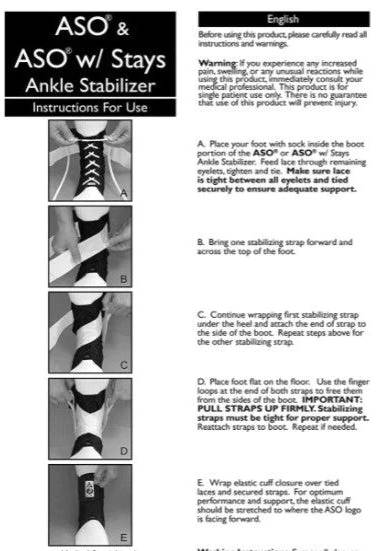
Ensure that the brace feels comfortable and supportive without causing any pain or discomfort. If needed, reposition the brace, loosen or tighten the laces, or make any other modifications to achieve the desired level of comfort and support. Remember, it is essential to follow the specific instructions provided with your ASO ankle brace, as the application process may vary slightly depending on the model or design. If you have any concerns or questions about putting on the brace, consult with a healthcare professional for personalized guidance.
Tips for Proper Fit and Wear
Importance of a snug but not overly tight fit: It is crucial to ensure that the ASO ankle brace fits snugly around your foot and ankle. Here's why:
- Support and Stability: A snug fit provides the necessary support and stability for your ankle. It helps prevent excessive movement that can lead to further injury or discomfort.
- Circulation: Avoid overtightening the brace as it may impede proper blood circulation. A snug fit should still allow for adequate circulation and prevent numbness or tingling in the foot.
- Comfort: While the brace should be secure, it should not be uncomfortably tight. Finding the right balance ensures both support and comfort during wear.
- Need for unrestricted ankle movement: While the ASO ankle brace provides support, it should not restrict your ankle's natural range of motion. Here are some considerations:
- Flexibility: The brace should allow you to move your ankle comfortably in various directions, including flexion, extension, and side-to-side movements.
- Natural Gait: Ensure that the brace does not alter your natural walking or running gait. Your foot should be able to roll smoothly from heel to toe without any restrictions.
- Gradual Progression: During the rehabilitation process, your healthcare professional may recommend gradually increasing your ankle's range of motion. The brace should accommodate this progression while still offering support.
Significance of wearing appropriate footwear with the brace: Pairing the ASO ankle brace with proper footwear is essential for optimal performance and comfort. Consider the following:
- Supportive Shoes: Choose footwear that provides ample support and cushioning for your feet and ankles. Athletic shoes designed for your specific activity are often recommended.
- Accommodating Size: Ensure that the shoes you wear can accommodate the bulk of the ankle brace comfortably. Avoid tight-fitting shoes that may compress your foot or cause discomfort.
- Secure Fit: Properly tie or fasten your shoes to ensure a secure fit, as this will complement the support offered by the ASO ankle brace.
By focusing on a snug but comfortable fit, allowing unrestricted ankle movement, and pairing the brace with appropriate footwear, you can maximize the effectiveness of the ASO ankle brace and promote a safe and comfortable recovery or injury prevention experience.
Care and Maintenance of the ASO Ankle Brace
Guidelines for cleaning and drying the brace: Proper care and maintenance of your ASO ankle brace are important to ensure its longevity and effectiveness. Follow these guidelines for cleaning and drying:
- Hand Wash: Gently hand wash the brace using mild soap and lukewarm water. Avoid using harsh chemicals or bleach.
- Spot Cleaning: Pay extra attention to areas that accumulate dirt or sweat, such as the inner lining or straps. Use a soft cloth or brush to remove any debris.
- Air Dry: Allow the brace to air dry completely before using it again. Avoid exposing it to direct sunlight or using a dryer, as excessive heat can damage the materials.
Importance of regular inspection for wear and tear: Regularly inspecting your ASO ankle brace helps ensure its ongoing functionality and effectiveness. Here's why:
- Detection of Damage: Check the brace for any signs of wear, fraying, or damage. Look for loose stitching, tears, or weakened areas that may compromise its support.
- Strap Integrity: Inspect the straps, closures, or laces for signs of deterioration or weakening. Ensure that they are in good condition and securely attached.
- Continued Support: A well-maintained brace provides consistent support. Regular inspection allows you to identify any issues early on and address them promptly.
When to replace the brace if it becomes worn out or loses effectiveness: Over time, the ASO ankle brace may wear out or lose its effectiveness. Here are some signs indicating the need for a replacement:
- Structural Integrity: If the brace shows significant signs of wear, such as stretched or weakened materials, it may no longer provide the necessary support and stability.
- Reduced Compression: If the brace fails to maintain proper compression or becomes too loose even after adjustments, it may be time for a replacement.
- Loss of Elasticity: Elastic components of the brace, such as straps or closures, may lose their elasticity over time, compromising the brace's ability to secure and support the ankle effectively.
- Changes in Fit: If your ankle size or shape changes, or if the brace no longer fits properly despite adjustments, it may be necessary to replace it with a size or model that suits your needs.
It is generally recommended to consult with a healthcare professional for guidance on when to replace your ASO ankle brace. They can assess the condition of the brace and provide personalized recommendations based on your specific situation. By following proper care and maintenance guidelines, regularly inspecting for wear and tear, and replacing the brace when necessary, you can ensure the ongoing effectiveness and longevity of your ASO ankle brace.
Additional Considerations and FAQs
Here are some common concerns and their corresponding explanations:
- Restriction of Movement: While ankle braces provide support, they are designed to allow for a certain degree of movement to maintain flexibility and prevent muscle atrophy. Choose a brace that strikes a balance between support and freedom of movement.
- Dependency on the Brace: It's natural to wonder if relying on an ankle brace will weaken your ankle over time. However, using a brace during the initial phases of recovery or for injury prevention does not automatically lead to dependency.
- Discomfort or Chafing: Ensuring the proper fit, wearing appropriate socks, and regularly inspecting the brace for any signs of wear can help minimize discomfort or chafing. Adjusting the brace's tightness and using additional padding, if recommended, can also alleviate discomfort.
Here are some frequently asked questions and their answers related to ASO ankle brace:
- Can I wear the ASO ankle brace with shoes? Yes, the ASO ankle brace is designed to be worn with shoes. Ensure you choose shoes that accommodate the bulk of the brace comfortably and securely fasten them for a proper fit.
- How long should I wear the ASO ankle brace each day? The duration of brace wear depends on your specific injury, recovery progress, and healthcare professional's advice. Follow their recommendations regarding the duration of daily wear, which may vary throughout your recovery journey.
- Can I wear the ASO ankle brace during sports activities? Yes, the ASO ankle brace is suitable for sports activities. It provides support and stability during dynamic movements. However, consult with your healthcare professional to determine if the brace is appropriate for your specific sport and level of activity.
- Can I sleep with the ASO ankle brace on? It is generally not recommended to sleep with the ASO ankle brace on unless specifically advised by your healthcare professional.
Giving your ankle time to rest and recover without the brace is important. Remember, it's crucial to consult with a healthcare professional for personalized advice and answers to any specific concerns or questions you may have about wearing the ASO ankle brace. They can provide guidance tailored to your individual circumstances and assist you throughout your recovery or injury prevention journey.
In conclusion, it’s important to prepare the brace for application, and individuals should have clean and dry feet before putting on the brace. By following our step-by-step guide for putting on the brace, you’ll achieve a snug but not overly tight fit. This will ensure the brace provides a balance between having enough support and having unrestricted ankle movement. Anytime the brace is worn, you should wear appropriate footwear.
It is crucial to follow our step-by-step guide outlined above when applying the ASO ankle brace. By carefully preparing, positioning, lacing, and adjusting the brace, you can ensure a secure and comfortable fit that promotes proper support and stability for your ankle.
Wearing an ankle brace, such as the ASO ankle brace, offers numerous benefits for both injury prevention and recovery. It provides support, stability, and compression, reducing the risk of ankle sprains and aiding in the healing process. By wearing an ankle brace, you can continue to engage in physical activities with added confidence and protection. Incorporating an ASO ankle brace into your routine can be a valuable tool for maintaining healthy ankles, preventing injuries, and supporting the recovery process. Remember to consult with a healthcare professional for personalized guidance and recommendations based on your specific needs.
